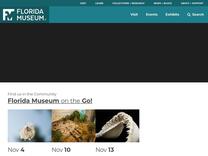Researcher receives NSF grant to study sea cucumbers – Research News https://www.floridamuseum.ufl.edu/science/researcher-receives-nsf-grant-to-study-sea-cucumbers/
Florida Museum of Natural History student François Michonneau recently received a $15,000 National Science Foundation grant to research sea cucumbers in Japan. The NSF Doctoral Dissertation Improvement Grant program provides partial support for projects to improve the quality of research in the b
and pollinators get a boost with two grants Five Facts Five Facts: Portuguese man-of-war

